The Kitchen is often referred to as the heart of the Home, And one of its most prominent features is the countertop. Installing new kitchen countertops can not only enhance the aesthetics of your space But also improve its functionality. Whether you’re embarking on a kitchen renovation Or simply looking to upgrade your existing countertops, the process can initially seem daunting. In this comprehensive Guide, We will take You through the step-by-step process of How to install Kitchen Countertops.
What Countertop Materials Are The Most Durable?
Choosing the right Countertop material is Crucial for Durability. Common options include granite, Quartz, marble, And laminate. Granite And quartz are renowned for their durability And resistance to heat, stains, And scratches. Marble, while elegant, may require more maintenance. Laminate is budget-friendly But less durable. Ultimately, Your choice should align with Your lifestyle And budget, Considering factors like maintenance, Aesthetics, And longevity.
How Do I Choose The Right Sink For My Countertop?
The Sink Selection is integral to Your Countertop Installation. Consider the sink’s size, shape, And material. Stainless steel And granite composite sinks are popular choices for their durability And easy maintenance. Undermount sinks provide a sleek look, While top-mount sinks are easier to install. Your sink choice should harmonize with Your countertop material And suit your cooking And cleaning needs.
Importance Of Installing Kitchen Countertops
Workspace And Food Preparation
One of the primary functions of a kitchen countertop organizer ideas is to provide a dedicated workspace for preparing meals. A spacious and well-designed countertop ensures you have enough room to chop, slice, dice, and mix ingredients efficiently. This enhances your cooking experience, making meal preparation a breeze.
Storage And Organization
Countertops also play a crucial role in kitchen organization. They serve as a platform for small appliances, cutting boards, and utensils, keeping everything within arm’s reach. Properly installed countertops can include features like built-in shelving or drawers, adding extra storage space to your kitchen.
Durability And Longevity
Investing in quality countertops can significantly increase the lifespan of your kitchen. Durable materials such as granite, quartz, or stainless steel can withstand the rigors of daily cooking and are resistant to stains and scratches. Properly installed countertops can last for decades, making them a wise long-term investment.
Here Are Some Ideas How To Install Kitchen Countertops
Preparing For Installation

Before diving into the installation process, thorough preparation is key. Start by measuring your kitchen to determine the size of the countertop you’ll need. Consider factors like overhangs and backsplashes, and ensure your measurements are accurate. Next, gather all the necessary tools and materials, including a tape measure, level, saw, drill, screws, adhesive, and safety gear.
Selecting The Right Countertop Material

Choosing the right countertop material is crucial for both functionality and aesthetics. Common options include granite, quartz, laminate, wood, and concrete. Consider your budget, maintenance preferences, and the overall style of your kitchen when making your selection. Research each material’s pros and cons to make an informed decision.
Removing Old Countertops
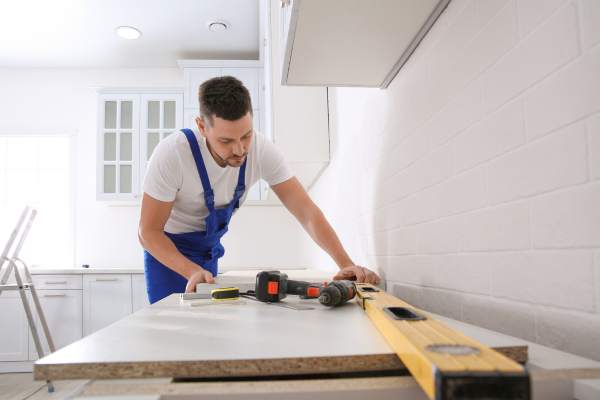
Before installing new countertops, you’ll need to remove the old ones. Start by turning off the water supply to the sink and disconnecting the plumbing. Carefully pry off the old countertops using a crowbar or similar tool. Dispose of the old material responsibly, and assess the condition of the base cabinets. Any necessary repairs should be made before proceeding.
Preparing The Base
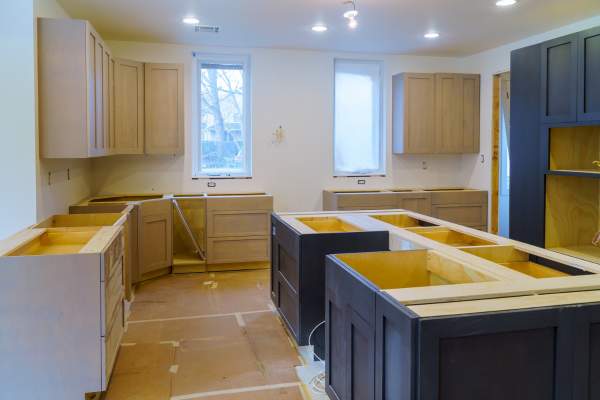
A solid base is essential for a successful countertop installation. Ensure that the cabinet framework is level and properly secured. Add support brackets where needed to provide additional strength, especially for heavy countertop materials. Finally, clean the base thoroughly to remove any debris or dust, which can affect the adhesion of the new countertops.
Installing Countertop Substrate

Once you’ve prepared the base cabinets, the next step is to install the countertop substrate. The substrate serves as a stable surface on which your countertops will rest. Common materials for substrates include plywood Or MDF (medium-density fiberboard). Measure and cut the substrate to fit the dimensions of your cabinets, Ensuring a precise fit. Secure the substrate to the cabinet framework using screws, Making sure it is level And even. If your countertop material requires additional support, Add bracing or supports underneath the substrate to distribute the weight evenly. This step is essential for a sturdy And long-lasting countertop installation.
Cutting And Shaping Countertops
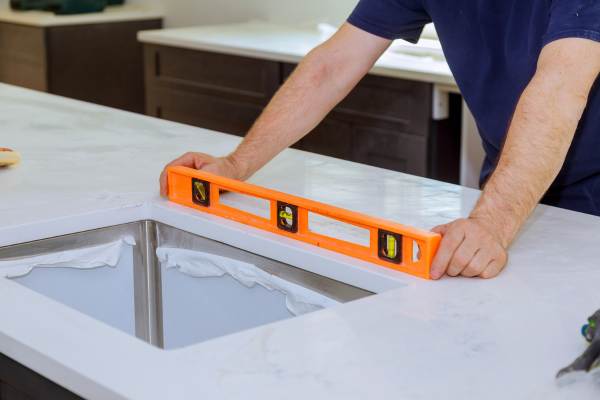
Cutting And shaping your chosen countertop material is a critical part of the installation process. Measure the countertop carefully, Marking any cut lines for sinks, cooktops, Or other fixtures. Use appropriate tools for cutting, such as a circular saw with a diamond-tipped blade for materials like granite or a jigsaw for wood or laminate. Wear safety gear, including eye protection and a dust mask, when cutting countertops to reduce health risks. Take Your time to ensure precise cuts, as inaccuracies can lead to ill-fitting countertops And potential issues during installation.
Fitting And Securing Countertops
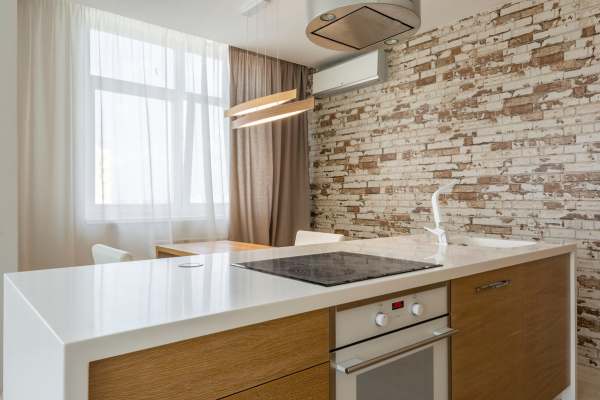
With your countertop substrate in place and the countertop material cut and shaped as needed, it’s time to fit and secure the countertops. Carefully lift the countertops into position, ensuring they align with the cabinet edges and any cutouts for fixtures. Apply a suitable adhesive, such as construction adhesive or silicone, to the top of the substrate to create a strong bond with the countertop material.
Gently press the countertop down onto the substrate, checking for levelness as you go. Secure the countertop from below using screws or brackets, following the manufacturer’s recommendations for your chosen material. Be cautious not to overtighten screws, as this can damage the countertop. Once secured, wipe away any excess adhesive, and your countertops will be ready for final touches like sealing and adding backsplashes.
Installing Sink And Faucet
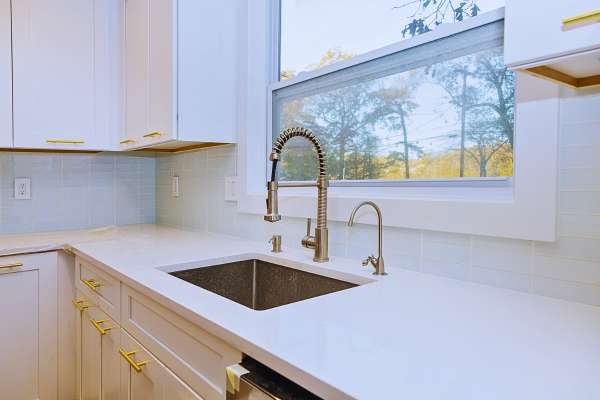
Installing the sink And faucet is a pivotal step in completing Your Kitchen countertop project. Begin by positioning the sink in its designated cutout, ensuring it fits snugly And aligns properly with the countertop and cabinet edges. Apply a bead of silicone caulk around the edge of the sink to create a watertight seal. Next, Mount the faucet according to the manufacturer’s instructions, making sure it aligns with the sink And countertop holes. Connect the water supply lines to the faucet, ensuring tight And leak-free connections. Finally, secure the sink to the countertop using clips Or brackets provided with the sink, Ensuring it is firmly in place.
Sealing And Finishing

To complete the countertop installation and protect it from moisture and stains, sealing is essential. The type of sealant you use will depend on your countertop material. For natural stone like granite or marble, use a stone-specific sealer. Laminate and solid surface countertops typically do not require sealing.
Apply the sealant evenly across the entire surface, using a clean, lint-free cloth or applicator. Be sure to follow the manufacturer’s instructions for drying and curing times. Once the sealant has dried, reattach any removed hardware and add finishing touches, such as backsplashes and trim pieces.
The Final Thought
Installing kitchen countertops is a rewarding And achievable project that can greatly enhance the functionality And aesthetic appeal of Your Kitchen. By following these step-by-step instructions, You can successfully install Your own countertops And save money on professional installation. Remember to carefully measure And plan your layout, Choose high-quality materials, And take your time during the installation process to ensure a seamless finish. Whether you opt for granite, quartz, Or laminate countertops, The end result will be a beautiful And durable surface that will withstand daily use for years to come.
